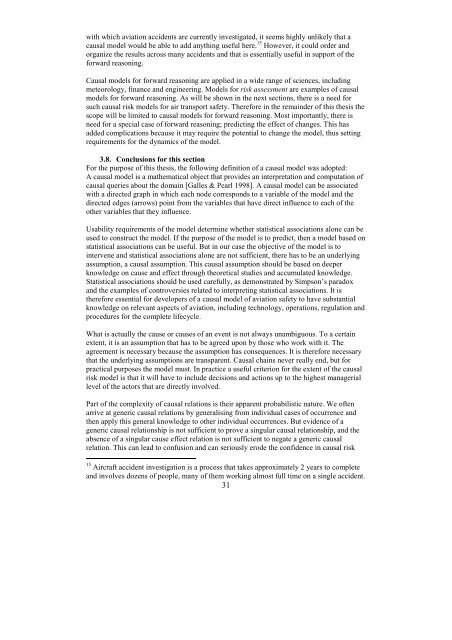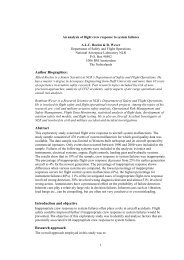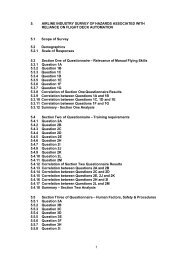Causal risk models of air transport - NLR-ATSI
Causal risk models of air transport - NLR-ATSI
Causal risk models of air transport - NLR-ATSI
Create successful ePaper yourself
Turn your PDF publications into a flip-book with our unique Google optimized e-Paper software.
with which aviation accidents are currently investigated, it seems highly unlikely that a<br />
causal model would be able to add anything useful here. 15 However, it could order and<br />
organize the results across many accidents and that is essentially useful in support <strong>of</strong> the<br />
forward reasoning.<br />
<strong>Causal</strong> <strong>models</strong> for forward reasoning are applied in a wide range <strong>of</strong> sciences, including<br />
meteorology, finance and engineering. Models for <strong>risk</strong> assessment are examples <strong>of</strong> causal<br />
<strong>models</strong> for forward reasoning. As will be shown in the next sections, there is a need for<br />
such causal <strong>risk</strong> <strong>models</strong> for <strong>air</strong> <strong>transport</strong> safety. Therefore in the remainder <strong>of</strong> this thesis the<br />
scope will be limited to causal <strong>models</strong> for forward reasoning. Most importantly, there is<br />
need for a special case <strong>of</strong> forward reasoning; predicting the effect <strong>of</strong> changes. This has<br />
added complications because it may require the potential to change the model, thus setting<br />
requirements for the dynamics <strong>of</strong> the model.<br />
3.8. Conclusions for this section<br />
For the purpose <strong>of</strong> this thesis, the following definition <strong>of</strong> a causal model was adopted:<br />
A causal model is a mathematical object that provides an interpretation and computation <strong>of</strong><br />
causal queries about the domain [Galles & Pearl 1998]. A causal model can be associated<br />
with a directed graph in which each node corresponds to a variable <strong>of</strong> the model and the<br />
directed edges (arrows) point from the variables that have direct influence to each <strong>of</strong> the<br />
other variables that they influence.<br />
Usability requirements <strong>of</strong> the model determine whether statistical associations alone can be<br />
used to construct the model. If the purpose <strong>of</strong> the model is to predict, then a model based on<br />
statistical associations can be useful. But in our case the objective <strong>of</strong> the model is to<br />
intervene and statistical associations alone are not sufficient, there has to be an underlying<br />
assumption, a causal assumption. This causal assumption should be based on deeper<br />
knowledge on cause and effect through theoretical studies and accumulated knowledge.<br />
Statistical associations should be used carefully, as demonstrated by Simpson’s paradox<br />
and the examples <strong>of</strong> controversies related to interpreting statistical associations. It is<br />
therefore essential for developers <strong>of</strong> a causal model <strong>of</strong> aviation safety to have substantial<br />
knowledge on relevant aspects <strong>of</strong> aviation, including technology, operations, regulation and<br />
procedures for the complete lifecycle.<br />
What is actually the cause or causes <strong>of</strong> an event is not always unambiguous. To a certain<br />
extent, it is an assumption that has to be agreed upon by those who work with it. The<br />
agreement is necessary because the assumption has consequences. It is therefore necessary<br />
that the underlying assumptions are transparent. <strong>Causal</strong> chains never really end, but for<br />
practical purposes the model must. In practice a useful criterion for the extent <strong>of</strong> the causal<br />
<strong>risk</strong> model is that it will have to include decisions and actions up to the highest managerial<br />
level <strong>of</strong> the actors that are directly involved.<br />
Part <strong>of</strong> the complexity <strong>of</strong> causal relations is their apparent probabilistic nature. We <strong>of</strong>ten<br />
arrive at generic causal relations by generalising from individual cases <strong>of</strong> occurrence and<br />
then apply this general knowledge to other individual occurrences. But evidence <strong>of</strong> a<br />
generic causal relationship is not sufficient to prove a singular causal relationship, and the<br />
absence <strong>of</strong> a singular cause effect relation is not sufficient to negate a generic causal<br />
relation. This can lead to confusion and can seriously erode the confidence in causal <strong>risk</strong><br />
15<br />
Aircraft accident investigation is a process that takes approximately 2 years to complete<br />
and involves dozens <strong>of</strong> people, many <strong>of</strong> them working almost full time on a single accident.<br />
31




